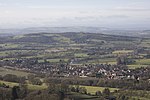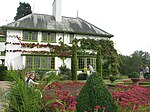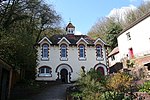Colwall railway station
1861 establishments in EnglandDfT Category F2 stationsFormer Great Western Railway stationsHerefordshire building and structure stubsRailway stations in Great Britain opened in 1861 ... and 5 more
Railway stations in HerefordshireRailway stations served by Great Western RailwayRailway stations served by West Midlands TrainsUse British English from February 2018West Midlands (region) railway station stubs

Colwall railway station is a railway station on the Cotswold Line serving the village of Colwall in Herefordshire, England. The station has one platform with seating. There is no ticket office; a passenger-operated Permit to Travel machine is installed, and there has been a ticket machine (for use with credit and debit cards only) since 2015. The station was opened in 1861, the same year as the Hereford and Worcester Railway Line. Today services are available direct to London Paddington, Birmingham and Hereford. To the west lies Ledbury Tunnel and to the east, the Colwall Tunnels. The station is close to the Colwall Park Hotel and the (now defunct) Malvern Water bottling plant.
Excerpt from the Wikipedia article Colwall railway station (License: CC BY-SA 3.0, Authors, Images).Colwall railway station
Station Road,
Geographical coordinates (GPS) Address Nearby Places Show on map
Geographical coordinates (GPS)
| Latitude | Longitude |
|---|---|
| N 52.08 ° | E -2.357 ° |
Address
Station Road
WR13 6JZ
England, United Kingdom
Open on Google Maps








